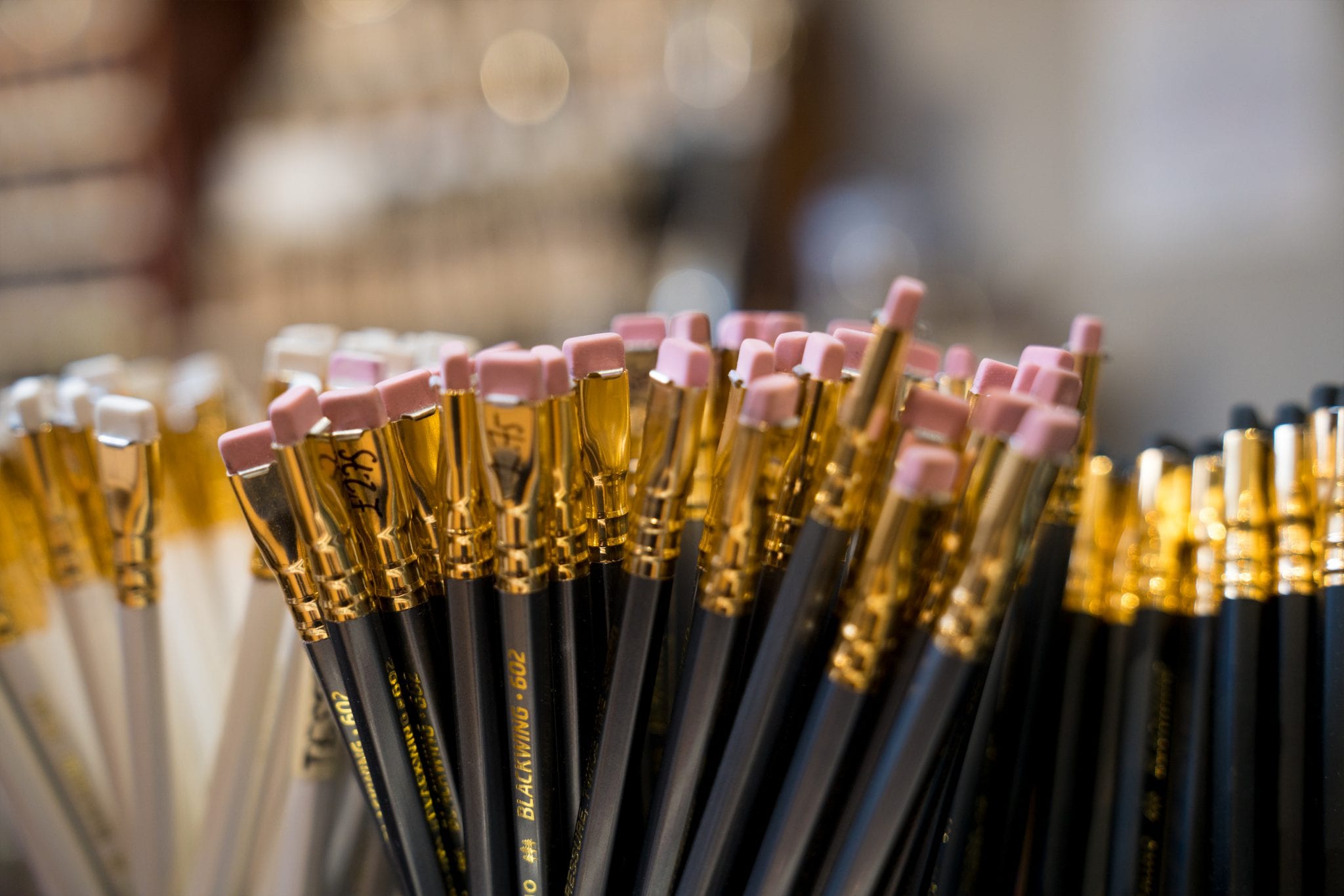
2B or not 2B, that is the question.
Indeed, it truly is the question when stood in the menagerie of pencils that is the downstairs rabbit warren of Green and Stone. In this place a cornucopia of pencils awaits you, including everything from the humble school pencil to the most suave, dark, and mysteriously named Pierre Noire.
First and foremost in the collection are the graphite pencils whose sheer variety of shapes, sizes and qualities will surprise those who think of pencils as merely being striped like a wasp and stuffed sadly in a neglected and shadowed drawer.
Particularly prized in the collection are the Caran d’Ache Grafwood pencils which have both style and substance. On their style, the silvery shafts are coloured in accordance with the graphite grade and have a hexagonal shaft to suit your grip, thus completing a sartorial draughtsman’s look (very important!). On their substance, the graphite is of the highest quality and is delectably soft and smooth, even in the hardest 4H grade. Also, in the Caran d’Ache range are the Grafcubes which are similarly soft solid cuboids of graphite perfect for expressive and gestural mark making.
From Derwent, there are the water-soluble graphite pencils which are ideal for making light sketches before using watercolours, whereby the underlying sketch will disappear when wett. Interestingly, if you are one who minds where your pencils are made, Derwent are the last remaining pencil factory in Britain. Based in the Lake District where graphite was first discovered in the mid-1500s they now make 14 million pencils a year using Californian cedar wood, pigments from across Europe, and China clay from Cornwall.
On the gradation of pencils, ‘B’ means black, and ‘H’ means hard, so 9B is very soft and black, HB is in the goldilocks zone, whilst 4H is very hard and pale. The gradation of pencils is made by cooking varying amounts of pure powdered graphite with clay. The purer the graphite content, the softer and blacker it is, and the more clay there is the harder and paler it is.
In the graphite collection there are also the excellent Faber Castell 9000’s, Koh-i-Noor’s Chunky pencils, Cretacolour tubs of graphite powder, and much, much more!
Away from the graphite pencils there are many shades of sanguine and fleshy tones in Derwent and Conté perfect for classical drawing techniques and drawing on toned papers. New to the collection are the Conté Pierre Noire’s which feature soft leads of dense, velvety matt black ideal for both lively and precise drawing. Also, in the Conté range are the Charcoal pencils which do not dirty your hands, provide a more accurate charcoal line and blend very well with their iron red and sepia cousins.
In the realm of coloured pencils there are traditional wax and oil-based pencils, watercolour pencils, and pastel pencils. Of the traditional coloured pencils there are the wonderful little Ferby’s which are delightfully chunky and vibrant, whilst at the top of the range there are the Caran d’Ache Luminance’s which are the finest of the fine! Whilst expensive they are worth every penny. They are smooth and can be easily blended with either burnishing, layering, or application of solvent. Most of all though, they remind you that coloured pencils are not always like the terrible, weak ones you had at school which frustrated more than they delighted. Instead, they are extraordinarily vivid and punchy, enough so that they can be mistaken for a painting. In addition, they are Grade I or II light fast, (important for any professional artist!). In a different corner of the shop there are the Carbothello’s which are pastel pencils. So, similarly to the charcoal pencils they do not mess your hands and provide a more accurate and steady pastel line.
Of the watercolour pencils there are the Faber Castell Albrect Durer’s which are also lightfast and strongly pigmented and can be used for both drawing and painting. Eagerly sought after by a select enlightened few the Stabilo Woody pencils have a naïve child-like look which belies their complexity. Indeed, these XXL pencils can be used as a pencil, a crayon, and a watercolour, and can make images so intensely vivid you will feel as though rainbows are falling out of your eyes. Truly, for only £1.45 you can experience pure psychedelia! Last, but not least there are the new Derwent Inktense pencils and blocks which are unique in that when wet they become ink, and once dry the colour is fixed and can be used on fabrics, including silk and cotton. Watch out Vivienne Westwood!
Hopefully, my point is a sharp and clear as that of my Faber Castell 9000 – there are a lot of pencils at Green and Stone! In truth, I have barely scratched the surface, there are many, many more to use (the chinagraph pencils which can write on all non-porous surfaces – what excitement awaits!).
However, if the idea of a pencil tires you out, you can be truly 18th century and use a port crayon instead. Et voila! You will be transported to an Enlightenment tea party.
By Ned Elliott